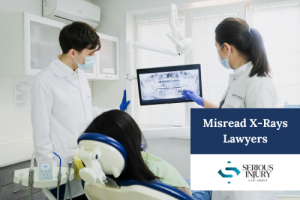Misread X-Rays Lawyers

An internal injury or disease can be very difficult to diagnose and treat. Taking too long to treat these kinds of ailments can have devastating health consequences. That’s why doctors rely on tools like X-rays and other types of diagnostic imaging to get a better look at the problem. But doctors and other healthcare providers make mistakes, and the machines they use aren’t always accurate. This can lead to costly errors that can leave patients in even worse shape than before they sought a diagnosis.
If you suffered from an X-ray misdiagnosis injury, the Alabama medical malpractice attorneys at the Serious Injury Law Group want to hear from you. Our lawyers only handle personal injury cases, giving us the unique insight and experience necessary to fight for your maximum compensation.
We also put a premium on customer service and responsiveness. We will meet with you wherever is most convenient for you. To schedule your free initial consultation, call us today or visit our contact page.
Can X-Rays Be Wrong?

X-ray images are a tool that healthcare providers use to diagnose and treat patients. Like all tools, their effectiveness depends on how they’re used. A major factor in the effectiveness of X-rays is the person who is interpreting the image. X-rays and other medical imaging tests require special training and knowledge to be interpreted correctly. If someone does not have this training and experience, they may make an error that can harm a patient.
Some of the most common causes of X-ray errors include:
- Issues with how the image was taken – X-rays and other diagnostic images need to be taken at the correct angle to provide the doctor with the best view of the injury or illness. If the image is taken from the wrong angle or the wrong kind of image is ordered, a doctor may not see the injury or may have an incomplete picture of it.
- Insufficient training – While doctors with medical degrees order imaging tests and X-rays, the test itself is often carried out by someone with less training. Inexperienced X-ray technicians may make a mistake that results in an inaccurate image.
- Interpretation errors – Interpretation errors occur when a doctor fails to see an injury on an X-ray or sees an injury but improperly diagnoses it. This is the most common type of X-ray error.
- Medical history errors – This is a particular kind of interpretation error that occurs when a doctor misses an injury on an X-ray because they haven’t fully reviewed a patient’s history. Without this information, a doctor may fail to notice an injury or illness.
- Malfunctioning equipment – The machines used to take an X-ray or other diagnostic images are complex, sensitive devices. The devices need to be used with care and properly maintained. Otherwise, they may give inaccurate information.
How Accurate Are X-Rays?
The accuracy of any individual X-ray depends on how well the image itself is taken and how well the reader interprets the image. One study that examined the effectiveness of chest X-rays in diagnosing pneumonia found that X-ray results were the least accurate in diagnosing the condition when compared to CT scans and chest ultrasounds.
Types of X-Rays
There are many kinds of X-rays, as well as other kinds of imaging that uses X-rays. Here are a few of the different kinds of X-rays healthcare providers may administer:
- Standard X-rays – These are the basic, two-dimensional images that most people are acquainted with. You can have an X-ray taken of your bones or other areas of your body.
- CT Scan – A CT Scan is when multiple X-rays are taken from multiple angles, then put together by a computer. This generates a more-detailed, 3-D image that can provide radiologists with more information about what’s happening in your body.
- PET Scan – A Positron Emission Tomography (PET) Scan uses radiation in a similar way to a CT Scan, except the device scans for radioactive tracers inside your body. These tracers are swallowed, inhaled, or injected into a vein.
A few kinds of imaging techniques work similarly to X-rays but do not involve radiation, such as:
- MRIs – Magnetic Resonance Imaging uses powerful magnetic fields to generate the image instead of X-ray radiation.
- Ultrasounds – Ultrasounds use sound waves to generate an image instead of radiation.
Like X-rays, MRIs and Ultrasounds require special equipment, knowledge, and experience to interpret correctly. This makes them just as vulnerable to error as X-rays.
Who Is Responsible for Misread X-Rays?
A correct X-ray diagnosis depends on a collective effort from a range of healthcare professionals. X-ray mistakes could be the fault of:
- The radiologist who ordered the X-ray if they misinterpreted the image in some way, or if they didn’t follow up to make sure the X-ray was actually carried out.
- The nurse or other support staff who took the X-ray if they mishandled the equipment or took the X-ray from the wrong angle.
- The designer or manufacturer of the X-ray machine if there’s some kind of design or manufacturing defect that leads to an X-ray fail.
- The facility where the X-ray was taken if staff mixed up your X-ray with someone else’s, if they didn’t provide the image to the doctor in a timely manner, or if they failed to properly maintain the machinery.
Talk to Our X-Ray Misdiagnosis Lawyers
Improper x-ray diagnosis claims can be difficult to prove. The dedicated, compassionate team at the Serious Injury Law Group is here to help you pursue compensation for the injuries you suffered due to medical malpractice reading X-rays. We are locally-owned and committed to protecting all members of our beautiful community. Schedule your free consultation today by calling us or visiting our contact page.
